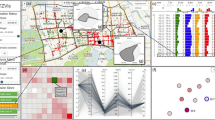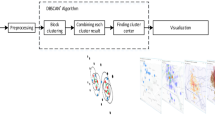Abstract
Public urban transport network has the characteristic of wide coverage, while buses have the features of stable running routes and static parking places, which is helpful to study urban traffic and bus station congestion patterns. Unlike the common GPS trajectory data, our data includes the pertinent records of the buses arrival and departure from the relevant bus stations due to data compression. In this paper, a visual analysis system called BVis is presented to analyze the urban traffic applying the large-scale real sparse buses dataset. This system covers the four modules of bus data visualization, first, the sparse trajectory data cleaning and mapping, second, the global traffic states and section traffic patterns analysis of roads, third, the bus station congestion patterns analysis using the station parking time, finally, an importance analysis of bus stations in the complex public transport network. Furthermore, an enhanced node importance evaluation algorithm is presented, which combines the dynamic properties of the bus station, such as traffic volume of station and station parking time. Using the real bus GPS dataset, three cases are described to demonstrate the performance and effectiveness of the system.
Graphical Abstract







Similar content being viewed by others
References
Al-Dohuki S, Wu Y, Kamw F, Xin L, Ye Z (2016) Semantictraj: a new approach to interacting with massive taxi trajectories, vol 23, pp 11–20
Andrienko N, Andrienko G (2011) Spatial generalization and aggregation of massive movement data. IEEE Trans Vis Comput Graph 17(2):205–219
D3 (2018) https://github.com/d3/d3/wiki/API
Ding XF, Hu Y, Zhao W, Wu RJ, Hu CL, Yang Y (2010) A study on the characters of the public opinion leader in web bbs. J Sichuan Univ 42(2):145–149
Ferreira N, Poco J, Vo HT, Freire J, Silva CT (2013) Visual exploration of big spatio-temporal urban data: a study of New York city taxi trips. IEEE TVCG 19(12):2149–2158
Guo H, Wang Z, Yu B, Zhao H, Yuan X (2011) Tripvista: triple perspective visual trajectory analytics and its application on microscopic traffic data at a road intersection. IEEE Pac Vis Sympos IEEE Comput Soc 18(1):163–170
Huang X, Zhao Y, Yang J, Zhang C, Ma C, Ye X (2016) Traj-graph: a graph-based visual analytics approach to studying urban network centralities using taxi trajectory data. IEEE TVCG 22(1):160–169
Leaflet (2018) http://leafletjs.com/reference-1.0.3.html
Liu D, Weng D, Li Y, Bao J, Zhang Y, Qu H (2017) Smartadp: visual analytics of large-scale taxi trajectories for selecting billboard locations. IEEE Trans Vis Comput Graph 23(1):1–10
Liu H, Gao Y, Lu L, Liu S, Qu H, Ni LM (2011) Visual analysis of route diversity. In: Proceedings of the IEEE VAST, pp 171–180
Ma Y, Lin T, Cao Z, Li C, Wang F, Chen W (2016) Mobility viewer: an eulerian approach for studying urban crowd flow. IEEE Trans Intell Transp Syst 17(9):2627–2636
OpenStreetMap (2018) http://www.openstreetmap.org
Scheepens R, Willems N, Wetering HVD, Andrienko G, Andrienko N, Wijk JJV (2011) Composite density maps for multivariate trajectories. IEEE Trans Vis Comput Graph 17(12):2518–2527
Sun X, Si S (2015) Complex networks algorithms and applications. National Defense Industry Press, Beijing
Tominski C, Schumann H, Andrienko G, Andrienko N (2012) Stacking-based visualization of trajectory attribute data. IEEE Trans Vis Comput Graph 18(12):2565–2574
Vespignani A (2010) Complex networks: the fragility of interdependency. Nature 464(7291):984
Wang Z, Lu M, Yuan X, Zhang J, Wetering HVD (2013) Visual traffic jam analysis based on trajectory data. IEEE Trans Vis Comput Graph 19(12):2159–2168
Wang Z, Ye T, Lu M, Yuan X (2014) Visual exploration of sparse traffic trajectory data. IEEE Trans Vis Comput Graph 20(12):1813–1822
Zeng W, Fu CW, Arisona SM, Qu H (2013) Visualizing interchange patterns in massive movement data. Comput Graph Forum 32(3):271–280
Zhang M, Xie J (2016) Node importance and its application in urban public transport network. Master’s thesis, Hebei Normal University
Acknowledgements
This work is supported by National Key Research and Development Program of China 317 (2016QY04W0801), the fund of Fundamental Sichuan Civil-Military Integration Institute (no. JMRH01) and the fund of 318 Sichuan Province Science and Technology Program (2017TJPT0200, 2017KZ0023, 2017GZ0186).
Author information
Authors and Affiliations
Corresponding author
Rights and permissions
About this article
Cite this article
Pei, W., Wu, Y., Wang, S. et al. BVis: urban traffic visual analysis based on bus sparse trajectories. J Vis 21, 873–883 (2018). https://doi.org/10.1007/s12650-018-0489-z
Received:
Revised:
Accepted:
Published:
Issue Date:
DOI: https://doi.org/10.1007/s12650-018-0489-z




